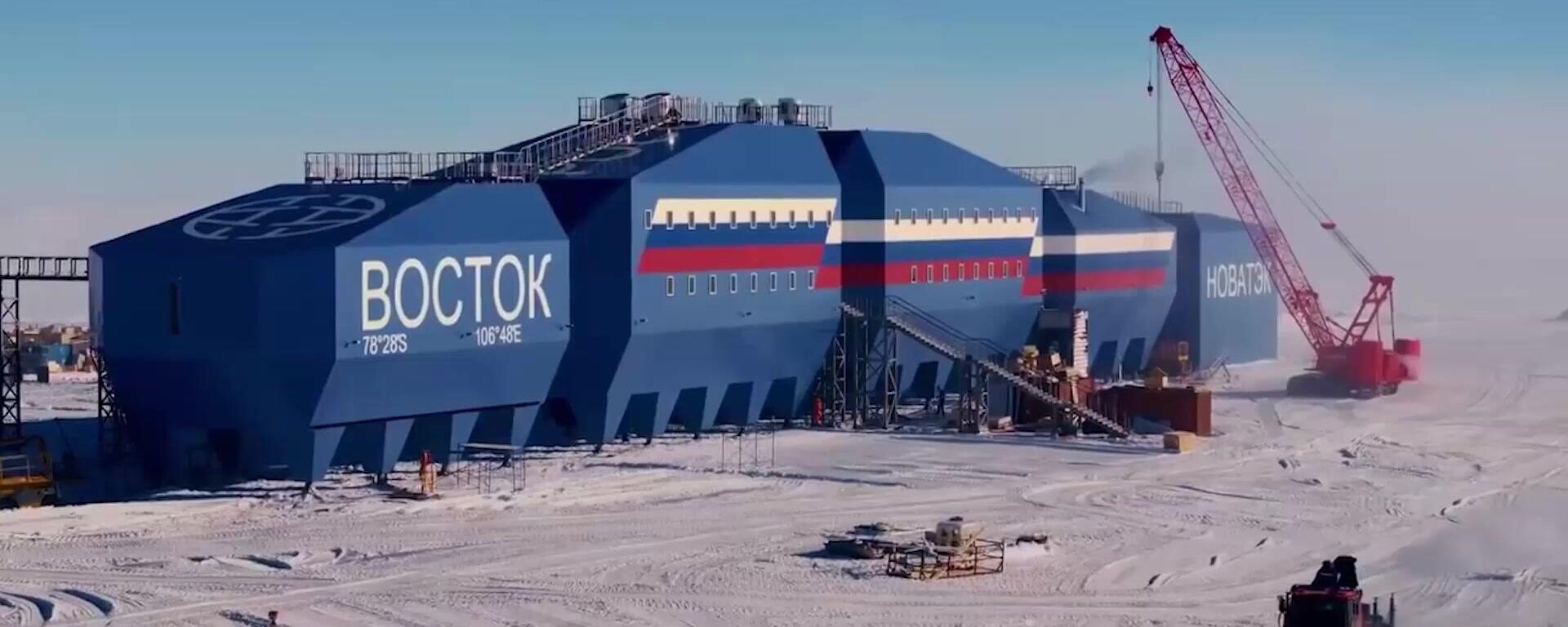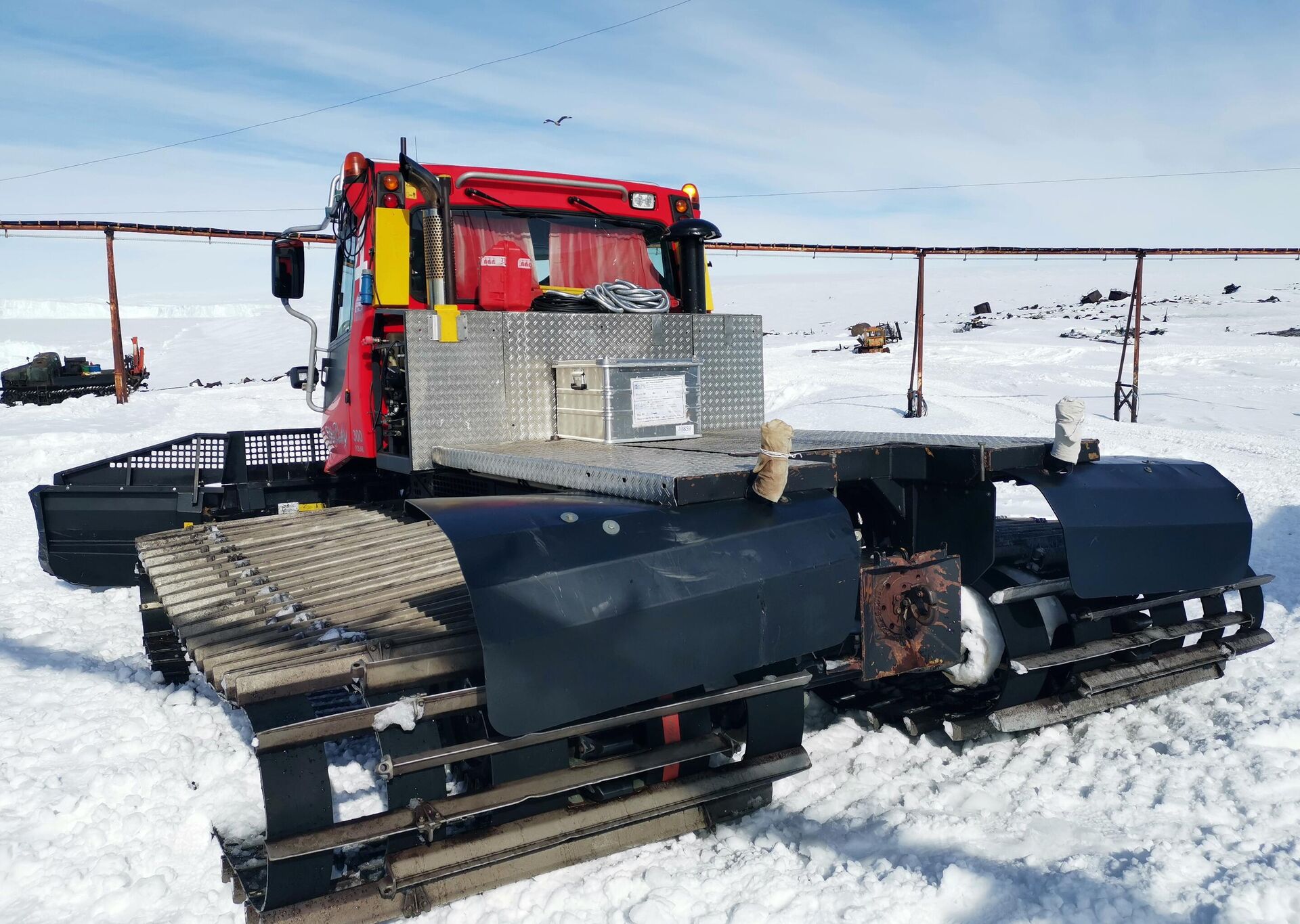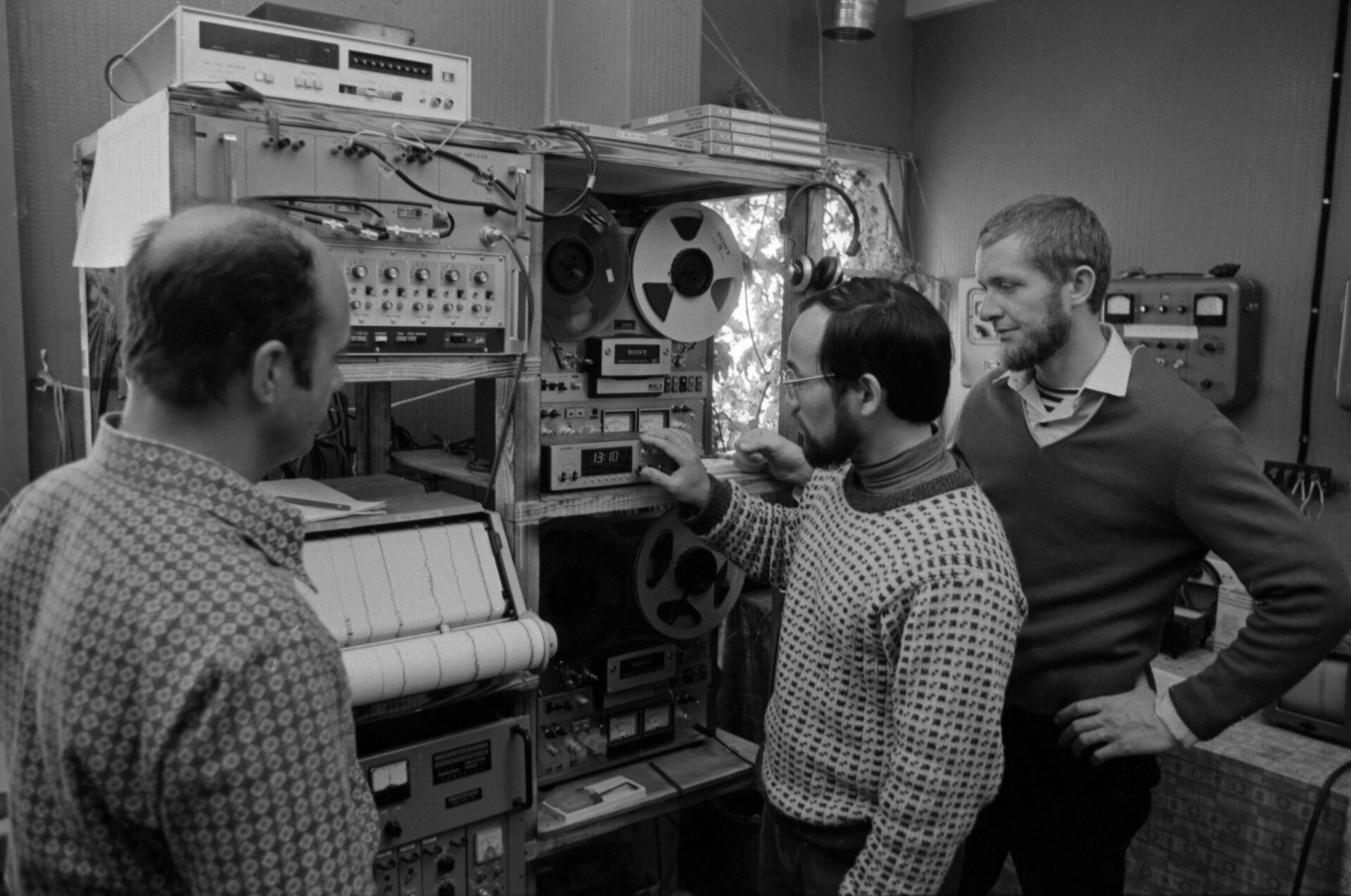https://sputnikglobe.com/20240128/what-are-russias-year-round-and-seasonal-research-stations-in-antarctica-1116452370.html
What are Russia's Year-Round and Seasonal Research Stations in Antarctica?
What are Russia's Year-Round and Seasonal Research Stations in Antarctica?
Sputnik International
President Vladimir Putin green-lit the trial operation of a new winter module at the Russian Vostok study station in central Antarctica on January 28. How many research stations does Russia have in the South Pole and what role do they play?
2024-01-28T18:58+0000
2024-01-28T18:58+0000
2024-01-30T10:29+0000
russia
world
antarctica
vladimir putin
alexander lukashenko
ussr
stations
antarctic
south pole
sputnik explains
https://cdn1.img.sputnikglobe.com/img/07e6/05/07/1095333842_0:131:2500:1537_1920x0_80_0_0_7d7b4772efbb3c713c9b17ca96df740c.jpg
Russian President Putin and his Belarusian counterpart Alexander Lukashenko remotely took part in the ceremony to inaugurate a new winter module at the Vostok research station in Antarctica on Sunday.However, Russia's record of Antarctic exploration is even greater. In the period from 1819 to 1821, the Russian south polar expedition on the vessels "Vostok" and "Mirny" under the command of Thaddeus Bellingshausen and Mikhail Lazarev approached the shores of an unknown ice continent several times. The continent was later named Antarctica at the end of the 19th century. The first confirmed sighting of the South Pole land mass is, therefore attributed, to the Russian expedition.Presently, Russia operates 10 research stations in the South Pole: five year-round facilities and five seasonal stations.Year-Round Stations:"Mirny": The station became operational in February 1956, becoming the first year-round Soviet center in the South Pole, located in Queen Mary Land on the Antarctic coast of the Davis Sea. After a short period, the station received special magnet, seismic and aerologic facilities. Geological, aerologic, gravimetric and other laboratories were also built there and a radio station located at the base ensured its direct connection to Moscow. Now, the station is mostly used for climatological and geophysics research."Vostok": The station was founded in 1957 during the second Soviet Antarctic expedition. It is located at an altitude of 3,500 meters in inland Princess Elizabeth Land near the South geomagnetic pole of the Earth making it possible for Russian researchers to observe changes in the Earth's magnetosphere."Novolazorevskaya": The station is located at the southeastern tip of the Schirmacher oasis and on the shores of Lake Stantsionnoye, Queen Maud Land. It was opened on January 18, 1961. It hosts an airfield: the runway was built in 1979 to receive Il-76 aircraft."Bellingshausen": The first Russian Antarctic station on the West Antarctica coast which was founded on February 22, 1968, at Collins Harbour on King George Island of the South Shetland Islands. It's the northernmost Russian Antarctic station providing capabilities for unique geological, glaciological and biological studies."Progress": The station, which is located at the Larsemann Hills Antarctica oasis on the shore of Prydz Bay, was founded on April 1, 1988. Initially, it was a seasonal base for geological and geophysical research, while in 2012 a new wintering complex was opened in it. By November 2022, Russia had built a new airfield near the station. The airfield allows bringing Russian expedition staff to Antarctica faster compared to traveling by ship.Seasonal Stations:"Molodezhnaya" started operating in 1962 and had long been considered the capital of Soviet Antarctica. There were about seventy buildings at the base, lined up into streets. Closed in 1999, it was switched to seasonal operations in 2006. It is located in the Thala Hills on the southern shore of Alasheyev Bight in the Cosmonaut Sea."Oasis Bangera" was founded in an Antarctic coastal oasis in the western part of Wilkes Land in 1987. The first Soviet base, initially installed in the Bunger Oasis in 1956, was donated to Poland and renamed Dobrovolskaya station."Druzhnaya-4" was founded in 1987 near Sandefjord Bay (Coronation Island) to ensure the logistic support to Soyuz Station and Progress Station. The climatic conditions in the base area are favorable for seasonal work."Leningradskaya" is located on the northern shore of Victoria Land on the Oates Coast. It became operational on February 25, 1971. It was used for studies of meteorology, Earth magnetism, oceanology and glaciology. It was closed in 1991, but the works at the station partially resumed after 2008."Russkaya" is located on the Ruppert Coast in Marie Byrd Land in Western Antarctica. It was opened on March 9, 1980, and closed in 1990. In 2008, it was reopened for seasonal research. In 2019, a decision was made to switch the station to year-round operation and work is still ongoing to make the necessary modifications.
https://sputnikglobe.com/20240128/putin-launches-new-complex-of-vostok-station-in-antarctica-1116449100.html
https://sputnikglobe.com/20230731/russian-scientists-succeed-in-growing-watermelons-in-antarctica--research-institute-1112277158.html
https://sputnikglobe.com/20240128/putin-says-russia-belarus-have-common-interests-in-antarctica-1116451318.html
russia
antarctica
ussr
antarctic
south pole
Sputnik International
feedback@sputniknews.com
+74956456601
MIA „Rossiya Segodnya“
2024
News
en_EN
Sputnik International
feedback@sputniknews.com
+74956456601
MIA „Rossiya Segodnya“
Sputnik International
feedback@sputniknews.com
+74956456601
MIA „Rossiya Segodnya“
russia, antarctica, vladimir putin, russian explorers in antarctica, soviet antarctic missions, russian year-round stations in antarctica, what are russia's year-round stations in antarctica, russia's seasonal stations in antarctica, what are russia's seasonal stations in antarctica
russia, antarctica, vladimir putin, russian explorers in antarctica, soviet antarctic missions, russian year-round stations in antarctica, what are russia's year-round stations in antarctica, russia's seasonal stations in antarctica, what are russia's seasonal stations in antarctica
What are Russia's Year-Round and Seasonal Research Stations in Antarctica?
18:58 GMT 28.01.2024 (Updated: 10:29 GMT 30.01.2024) President Vladimir Putin green-lit the trial operation of a new winter module at the Russian Vostok study station in central Antarctica on January 28. How many research stations does Russia have in the South Pole and what role do they play?
Russian President Putin and his
Belarusian counterpart Alexander Lukashenko remotely took part in the ceremony to inaugurate
a new winter module at the Vostok research station in Antarctica on Sunday.
"Our scientists have been constantly working in Antarctica since 1955. They have made hundreds of great discoveries," Putin continued.
However, Russia's record of
Antarctic exploration is even greater. In the period from 1819 to 1821, the Russian south polar expedition on the vessels "Vostok" and "Mirny" under the command of Thaddeus Bellingshausen and Mikhail Lazarev approached the shores of an unknown ice continent several times. The continent was later named Antarctica at the end of the 19th century. The first confirmed sighting of the South Pole land mass is, therefore attributed, to the Russian expedition.
The next trip of Soviet Russian sailors to the South Pole took place 145 years later. A vast network of the nation's Antarctic stations had been built in the 20th century. Since then, the stations have been used for environmental and climate observations, coastal waters and sea ice studies, research covering the intensity of cosmic radiation, seismic fluctuations of the lithosphere, and biodiversity.
Presently, Russia operates 10 research stations in the South Pole: five year-round facilities and five seasonal stations.

28 January 2024, 12:50 GMT
"Mirny": The station became operational in February 1956, becoming the first year-round Soviet center in the South Pole, located in Queen Mary Land on the Antarctic coast of the Davis Sea. After a short period, the station received special magnet, seismic and aerologic facilities. Geological, aerologic, gravimetric and other laboratories were also built there and a radio station located at the base ensured its direct connection to Moscow. Now, the station is mostly used for climatological and geophysics research.
"Vostok": The station was founded in 1957 during the second Soviet Antarctic expedition. It is located at an altitude of 3,500 meters in inland Princess Elizabeth Land near the South geomagnetic pole of the Earth making it possible for Russian researchers to observe changes in the Earth's magnetosphere.
"Novolazorevskaya": The station is located at the southeastern tip of the Schirmacher oasis and on the shores of Lake Stantsionnoye, Queen Maud Land. It was opened on January 18, 1961. It hosts an airfield: the runway was built in 1979 to receive Il-76 aircraft.
"Bellingshausen": The first Russian Antarctic station on the West Antarctica coast which was founded on February 22, 1968, at Collins Harbour on King George Island of the South Shetland Islands. It's the northernmost Russian Antarctic station providing capabilities for unique geological, glaciological and biological studies.
"Progress": The station, which is located at the Larsemann Hills Antarctica oasis on the shore of Prydz Bay, was founded on April 1, 1988. Initially, it was a seasonal base for geological and geophysical research, while in 2012 a new wintering complex was opened in it. By November 2022, Russia had built a new airfield near the station. The airfield allows bringing Russian expedition staff to Antarctica faster compared to traveling by ship.
"Molodezhnaya" started operating in 1962 and had long been considered the capital of Soviet Antarctica. There were about seventy buildings at the base, lined up into streets. Closed in 1999, it was switched to seasonal operations in 2006. It is located in the Thala Hills on the southern shore of Alasheyev Bight in the Cosmonaut Sea.
"Oasis Bangera" was founded in an Antarctic coastal oasis in the western part of Wilkes Land in 1987. The first Soviet base, initially installed in the Bunger Oasis in 1956, was donated to Poland and renamed Dobrovolskaya station.
"Druzhnaya-4" was founded in 1987 near Sandefjord Bay (Coronation Island) to ensure the logistic support to Soyuz Station and Progress Station. The climatic conditions in the base area are favorable for seasonal work.
"Leningradskaya" is located on the northern shore of Victoria Land on the Oates Coast. It became operational on February 25, 1971. It was used for studies of meteorology, Earth magnetism, oceanology and glaciology. It was closed in 1991, but the works at the station partially resumed after 2008.
"Russkaya" is located on the Ruppert Coast in Marie Byrd Land in Western Antarctica. It was opened on March 9, 1980, and closed in 1990. In 2008, it was reopened for seasonal research. In 2019, a decision was made to switch the station to year-round operation and work is still ongoing to make the necessary modifications.
Commenting on the Vostok station's modernization, Russian President Vladimir Putin emphasized: "I am convinced that the new station will strengthen cooperation between scientists from different countries and will become an open platform for solving pressing problems in the field of studying nature and the environment, and, of course, for promoting joint innovative and scientific programs within the framework of the Union State of Russia and Belarus."

28 January 2024, 15:54 GMT








